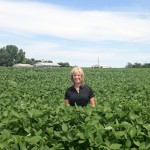If you would have told me 10 years ago that I would not only be attending a local plot tour focused on soybeans, but that they would make up 20 per cent of my farm’s acres, I would have never believed you. The changes and advancements in the varieties of crops we can grow here […] Read more

Soybeans in Saskatchewan
Field notes: At a summer plot tour, Southeast Saskatchewan farmer Bobbie Bratrud took a look at some new varieties and crops that could give her farm a competitive edge
6 tips for straight combining canola
Most Western Canadian farmers consider swa-thing canola to be the tried and true harvest management strategy. But straight combining could allow farmers to reduce a field operation and gain extra yield from producing larger seed size nurtured by a fully matured plant. Straight combining canola can be risky because of shatter losses if timing is […] Read more
How and why to tissue test your plants
Many farmers believe that the health and productivity of their soil is one of the largest influences on their farm’s productivity and profitability. Successful farmers know that while many of the properties that make up our soil are static and change very slowly over time (if at all), nutrient availability is one of the largest […] Read more
Foliar Fertilizer
When you’re sitting on the tractor seeding with auto steer you have a lot of time to think. It’s always mind blowing to figure out how much money is going into the crop with every pass. Most Western Canadian farms take the plunge at seeding time and place down a good portion of their variable […] Read more
To Swath Or Not — Harvest Management Of Lentils
Success in lentil production is most often measured by yield production but equally important is the quality that farmers are able to pull out of the field. Each year is different and the last couple have dealt most of us a tough hand. Rain and poor weather at harvest is hard to handle, and at […] Read more
Clearfield Lentil Commitment Changes For 2011
Common sense tells all of us that before we sign a contractual agreement we should fully understand all of the terms and agreements. As farmers, we often simply sign an agreement that is put in front of us by our retailer and view it as just one more thing that we need to do to […] Read more
Five Steps To Optimum Pea And Lentil Seeding
Pea and lentil acres make up a critical portion of our acres each year. For some, seeding and production management of pulses is old hat, but for many, there’s much to learn about pulse production. While conditions and specifics will vary slightly depending on where you farm in Western Canada, there are some rules of […] Read more
A List Of Spring Burn-Off Options
Farmers know it and the research shows it — timely removal of competing weeds has a profound effect on crop competitiveness and yield potential. We’ve all likely experienced when spring burn-off is less than acceptable, either because of uncooperative weather or poor control that leaves more advanced weeds to choke out the crop. To add […] Read more
Seven Steps To Reduce Fungicide Resistance
Prairie crop production is being more intensively managed than ever before. Tight economic margins, developments in crop genetics and pushing crop rotations are factors, as is the influence young educated farmers moving into decision-making roles. This, along with the slow reduction of input costs due to increased competition and products coming off patent has made […] Read more
Three Tips For Choosing Pulse Fields
Once you’ve decided on your canola acres and booked your seed, it’s time to consider which fields are suitable for pulses. Even if you have a set rotation, you may be adding some new land, combining smaller fields into a larger one, or reacting to market prospects. In our area, we’ve seen a gradual decline […] Read more

